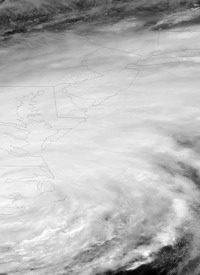
Hurricane warnings were issued from North Carolina to New York and to the islands of Nantucket and Martha’s Vineyard. Evacuation orders have transported at least 2.3 million people.
Jay Baker, a geography professor at Florida State University, said, “This is probably the largest number of people that have been threatened by a single hurricane in the United States.”
The hurricane began as a Category 3 hurricane but was downgraded to a Category 2 by the National Hurricane Center in Miami before it was ultimately declared a Category 1 hurricane as it slammed into Cape Lookout, North Carolina at 7:47 a.m., with maximum sustained winds at around 85 mph.
Thus far, one death has resulted from the storm, as a man 150 miles from the Atlantic coast was hit by the branch of a tree brought down by Irene’s winds. More than 200,000 residents on the southern coast of North Carolina are already without power.
New York, Maryland, North Carolina, Virginia, Connecticut, Massachusetts, and New Jersey have already declared states of emergency.
New York City Mayor Michael Bloomberg has ordered mandatory evacuations in areas like Battery Park City, Coney Island, Manhattan Beach, Far Rockaway, and Staten Island. Some residents have refused to leave, however.
“There’s no way in hell that we are leaving home,” said Pat Jones, a resident of New York’s Rockaways for 30 years. “This is my home, and I’m staying here and protecting my home. Wouldn’t you?”
In response to these individuals, Bloomberg said that ignoring the evacuation orders “isn’t cute.” He adds, “Heed these warnings and get yourself to safety before the bad weather hits…If you don’t follow this, people may die.”
Meanwhile, New York City public transportation has been stopped since noon today. Shelters in New York City have been opened since Friday after the city was placed under its first hurricane warning since 1985.
New York City is preparing for nightmare scenarios. If the hurricane passes near Manhattan, the potential for shattered glass falling from skyscrapers remains. Likewise, flooded subways and seawater rushing through the streets in New York City are frightening but realistic occurrences to consider.
The Huffington Post reports:
Even if the winds aren’t strong enough to damage buildings made largely of brick, concrete and steel, a lot of New York’s subway system and power lines are underground. The city’s airports are close to the water, too, and could be inundated, as could densely packed neighborhoods. Hospitals were told to make sure generators were ready.
According to Susan Cutter, director of the Hazards and Vulnerability Research Institute at the University of South Carolina, “In many ways, a Category 2 or stronger storm hitting New York is a lot of people’s nightmare, for a number of reasons.”
In New Jersey, Governor Chris Christie ordered mandatory evacuations, particularly in coastal Cape May, Atlantic, Ocean, and Monmouth Counties, which include Atlantic City and other cities on the New Jersey Shore. When Christie learned that some remained on New Jersey’s beaches as late as Friday evening, he ordered them to “get the hell off the beach.”
Atlantic City casinos have been shut down since noon today in anticipation of the hurricane, as well as New Jersey transit trains and PATH trains to Manhattan. However, New Jersey Transit buses are still in use to move residents off the beach into the Sun Center arena in Trenton.
Delaware Governor Jack Markell has ordered an evacuation of all those in coastal areas shared with Maryland and Virginia.
Residents in Baltimore at Fells Point, a waterfront, have filled sandbags and placed them at the entrances to buildings, while cargo ships have been moved out of the Port of Baltimore.
Residents in Ocean City, Maryland have already been evacuated, while businesses on the boardwalk boarded up their stores and left behind signs that read “Irene don’t be mean!”
While the hurricane has been downgraded to a Category 1, NHC hurricane specialist Mike Brennan warns, “The hazards are still the same. The emphasis for this storm is on its size and duration, not necessarily how strong the strongest winds are.”
As the hurricane has passed North Carolina Outer Banks and continues to head north, officials in Washington are imploring Americans to be prepared.
“Don’t wait. Don’t delay,” said President Obama, who was forced to cut short his summer vacation as a result of the storm. “I cannot stress this highly enough: If you are in the projected path of this hurricane, you have to take precautions now.”
In North Carolina, officials have already been used to rescue people from homes. Fox News reports:
Officials already had started rescuing some people from homes in Craven County. Stanley Kite, the county’s emergency services director, said about 2 feet of water pushed from Pamlico Sound into the Neuse River and was spreading into neighborhoods. The Bouge Sound was also sending a few feet of water onto roads and into homes at Salter Path, and at least two piers on the Outer Banks were wiped out.
The hurricane heads to southeast Virginia, which is reportedly vulnerable to storm surges as a result of the inlets and rivers there.
Thus far, over 6,000 flights from have grounded as airports in major cities like Washington, D.C. and Boston prepare for Irene.
For now, the Weather Channel predicts that the mouth of Hurricane Irene should be at Chesapeake Bay by this evening and continue to move up the east coast arriving in Long Island on Sunday. The storm is expected to land in New England as a minimal hurricane, with tropical storm force winds inland and hurricane force winds along the coast.
Photo: AP Images




